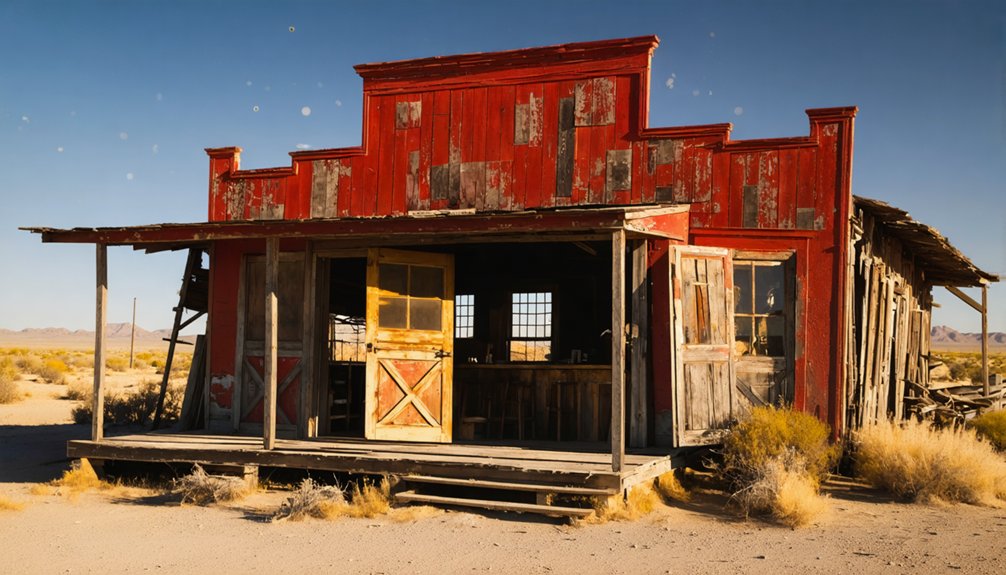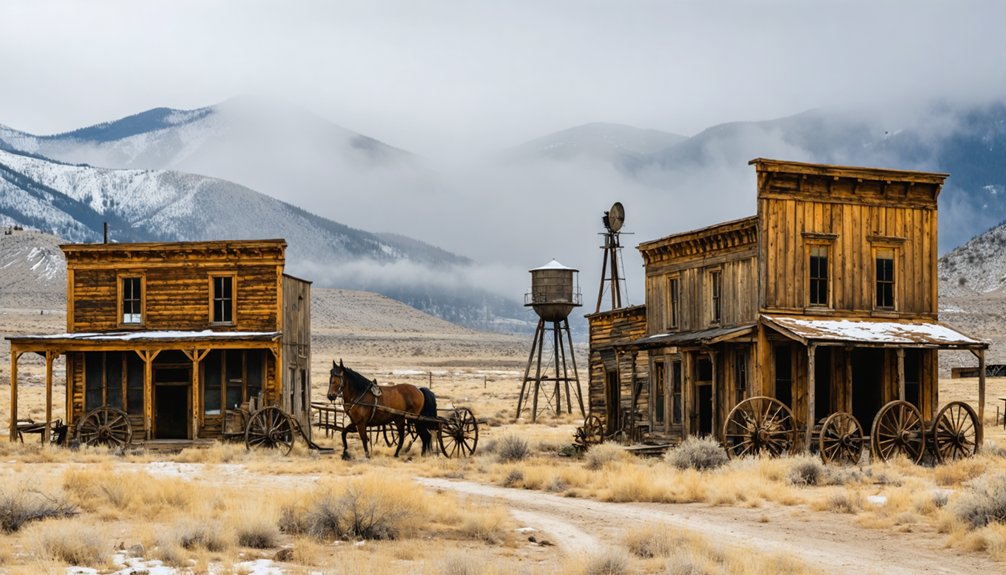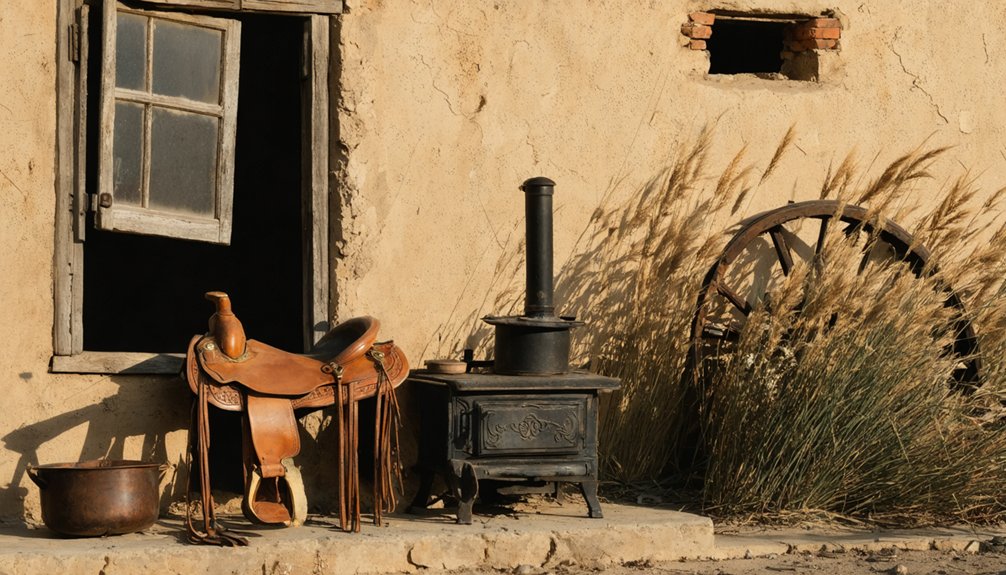Exploring abandoned Old West settlements offers a window into America’s mining boom era. You’ll discover architectural remnants, historical artifacts, and stories of frontier life when visiting sites like Bodie, California or Virginia City, Nevada. Pack essentials including sturdy boots, multiple light sources, and navigation tools. Always practice responsible tourism by staying on designated paths and leaving artifacts undisturbed. The preserved structures and landscapes await your respectful discovery.
Key Takeaways
- Visit well-preserved ghost towns like Bodie, Garnet, and Tombstone to experience authentic Old West history.
- Bring essential gear including sturdy boots, multiple light sources, navigation tools, and protective clothing.
- Photograph during golden hour for best lighting, use tripods for stability, and shoot in RAW format.
- Practice responsible tourism by following Leave No Trace principles and never removing artifacts from sites.
- Learn about the boom-and-bust cycles, architectural styles, and socio-economic conditions that shaped these settlements.
The Rise and Fall of Mining Boomtowns

While the nineteenth-century American West has often been romanticized in popular culture, the reality of mining boomtowns presents a complex historical narrative of economic volatility and social transformation.
When you explore these abandoned settlements, you’re witnessing the remnants of dramatic boom-bust cycles exemplified by places like Goldfield, Nevada, which rapidly became the state’s largest city only to decline precipitously by the 1920s.
These towns emerged virtually overnight following mineral discoveries, creating economic impacts that rippled through entire regions. The 1840s gold rush attracted thousands to California, significantly altering migration patterns and permanently reshaping settlement across the western territories.
Virginia City grew to 25,000 residents after the 1859 Comstock Lode discovery, extracting over $320 million in precious metals within three decades.
Mining challenges included gender imbalances as high as 9-to-1 and ethnic tensions amid industrial-scale operations requiring substantial capital investment.
The rowdy environments that characterized these settlements often led to various forms of lawlessness until more stable governance could be established.
Must-Visit Ghost Towns of the American West
When travelers venture into America’s western ghost towns today, they encounter far more than dilapidated buildings—they’re stepping into meticulously preserved fragments of frontier life that offer tangible connections to the nation’s westward expansion.
California’s Bodie State Historic Park presents over 100 original structures and mining relics where the Standard Mill Tour demonstrates gold processing techniques.
Montana’s Garnet preserves 30 intact buildings, making it the state’s most complete ghost town history site. The popular Sierra Mine Loop provides visitors with access to early mining sites complete with informative historical signage.
Wyoming’s South Pass City offers nearly two dozen restored buildings along the Oregon Trail, while Nevada’s Rhyolite features its distinctive bottle house.
Jerome’s copper boom legacy lives on through restored buildings and art galleries.
At Tombstone, a National Historic Landmark since 1961, you’ll experience one of the best-preserved specimens of 1870s frontier architecture.
Kennecott in Alaska captivates visitors with its striking red mill buildings that stand in dramatic contrast to the surrounding wilderness in Wrangell-St. Elias National Park.
What to Pack for Ghost Town Exploration
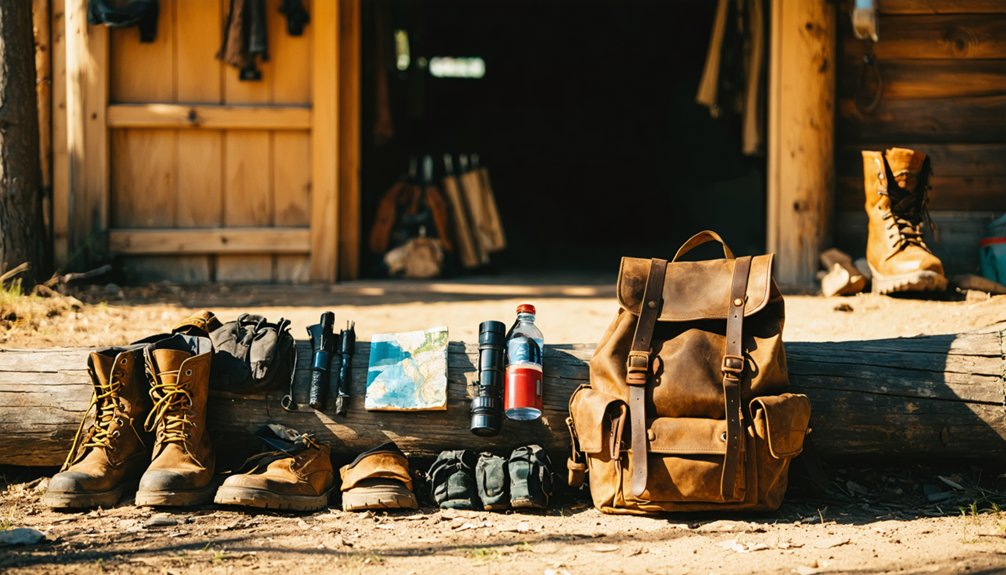
Thorough preparation serves as the foundation for a rewarding ghost town exploration experience. Your essential gear should include a compact, waterproof backpack containing multiple light sources—at least two reliable torches per person and a hands-free headlamp with extra batteries for each.
A thorough explorer packs wisely—waterproof backpack, multiple torches, and headlamps with extra batteries ensure illumination throughout your adventure.
For personal protection, wear sturdy boots, long-sleeved clothing, and gloves to shield against hazardous terrain and debris. Don’t forget respiratory protection when entering dust-filled structures. Consider bringing additional storage solutions such as spare high-capacity memory cards to ensure you never miss documenting important discoveries. The Shadowhawk LED Torch is particularly recommended for its brightness and durability when exploring dimly lit abandoned structures.
Safety tips: Always carry a well-stocked first aid kit, sufficient water, and energy-sustaining snacks. Navigation tools and communication devices with backup power are non-negotiable, especially in remote locations.
Include a multi-tool for unexpected situations and proper identification or permits to avoid legal complications. This methodical approach guarantees you’re prepared while maintaining the freedom to explore these historical remnants safely.
Photography Tips for Capturing Abandoned Settlements
Capturing the haunting beauty of abandoned Old West settlements requires specialized photographic techniques that balance technical precision with artistic vision.
Mount your camera on a tripod for stability, particularly during low-light conditions and long exposures. Shoot in RAW format to maximize post-processing flexibility, while manually focusing to overcome autofocus limitations among textured surfaces.
For composition techniques, start with establishing shots of main streets or prominent buildings before focusing on architectural details, artifacts, and signage that tell the location’s story. Understanding the four classifications of ghost towns will help you determine appropriate photographic approaches for each location type.
Experiment with layering elements and reflections to create visual depth.
Your lighting strategies should leverage golden hour’s soft illumination for daytime shoots or moonlight for nightscapes.
Consider light painting to selectively highlight features during night photography, using gels to maintain color harmony that evokes the appropriate mood.
Developing an eye for lush color and texture in decaying structures will enhance the visual impact of your photographs, creating a compelling contrast between abandonment and beauty.
Responsible Tourism and Preservation Ethics
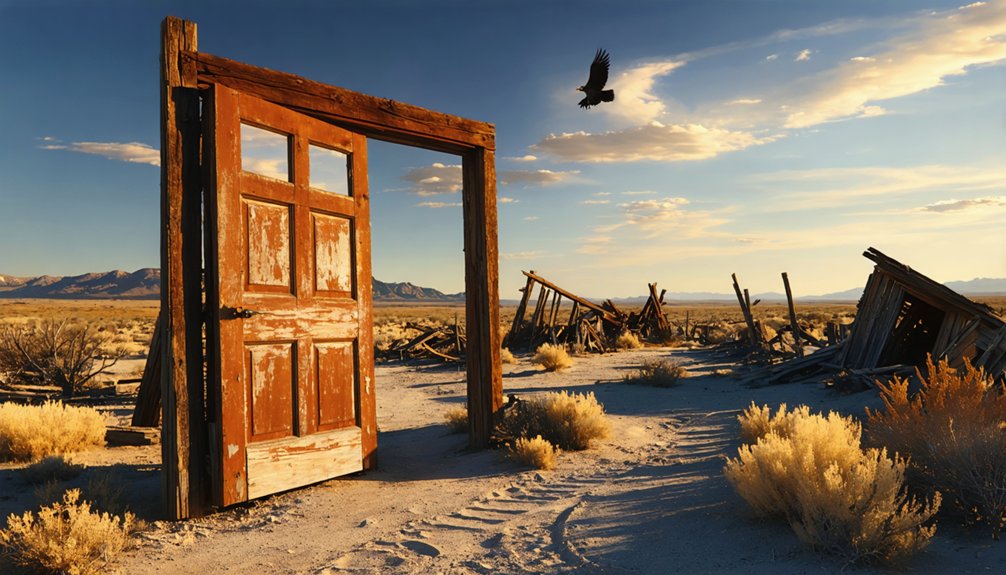
While photography preserves abandoned settlements visually, ethical visitation practices guarantee their physical preservation for future generations. As you explore these historic treasures, your adherence to sustainable practices becomes critical to their longevity.
The principle of minimal intervention—touching nothing and altering nothing—safeguards the authentic character that makes these sites culturally significant.
Responsible visitor etiquette includes:
- Following all local regulations and remaining in designated areas
- Practicing Leave No Trace principles—carrying out everything you bring in
- Respecting property boundaries and leaving artifacts undisturbed
These abandoned settlements represent non-renewable cultural resources requiring protection through conscientious tourism. Your actions directly impact whether these fragile windows into frontier life remain intact for subsequent generations.
The preservation of these sites depends on your commitment to responsible exploration balanced with conservation ethics. Many ghost towns have disappeared due to weather and vandalism, making your responsible visitation practices even more crucial. Remember that removing historical items is not only unethical but undermines the code of ethics established to protect these remarkable places.
Frequently Asked Questions
Are Ghost Towns Legally Accessible at Night or During Off-Seasons?
Nighttime access to ghost towns is generally illegal without explicit permission. You’ll face trespassing charges and penalties. Seasonal restrictions further limit your exploration opportunities, requiring you to secure proper authorization beforehand.
How Dangerous Are Wildlife Encounters in Abandoned Western Settlements?
Under starlit western skies, you’ll find wildlife encounters are typically low-risk. Maintain wildlife safety by respecting animals’ space. Predator encounters remain rare, though coyotes and raccoons may carry diseases if approached carelessly.
Can Metal Detectors Be Used at Ghost Town Sites?
Metal detecting is typically illegal at protected ghost towns. You’ll need written permission on private land. For ethical treasure hunting, research ownership status and applicable laws before using your metal detector.
Do Indigenous Communities Have Concerns About Ghost Town Tourism?
Indigenous communities have overwhelmingly significant concerns about ghost town tourism. You’ll need to navigate cultural sensitivity issues surrounding sacred sites and support indigenous-led preservation efforts that respect tribal sovereignty over ancestral territories.
What Paranormal Investigations Have Yielded Compelling Evidence at Ghost Towns?
You’ll find the most compelling paranormal encounters at Thurmond’s Mankin-Cox Building, where investigators documented ghostly apparitions, flashlight communications, and SLS camera evidence of spirits, particularly one named Barbara, interacting with researchers.
References
- https://www.blackhillsbadlands.com/blog/post/old-west-legends-mines-ghost-towns-route-reimagined/
- https://www.geotab.com/ghost-towns/
- https://explorethearchive.com/western-ghost-towns
- https://www.visitutah.com/things-to-do/history-culture/ghost-towns
- https://mwg.aaa.com/via/places-visit/western-ghost-towns
- https://www.youtube.com/watch?v=yeTVfoQxqJc
- https://www.legendsofamerica.com/gt-hiddentales/
- https://wildwestcity.com/old-west-ghost-towns/
- https://historycollection.com/dust-guns-and-gold-inside-the-earliest-cowboy-towns-that-built-the-wild-west/
- https://en.wikipedia.org/wiki/Lists_of_ghost_towns_in_the_United_States
